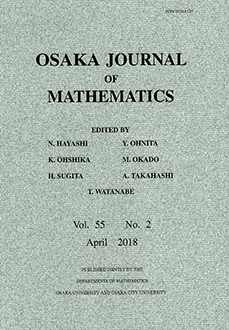Abstract
Let $(X^n, \check{X}^n)$ be a mirror pair of an $n$-dimensional complex torus $X^n$ and its mirror partner $\check{X}^n$. Then, a simple projectively flat bundle $E(L,\mathcal{L})\rightarrow X^n$ is constructed from each affine Lagrangian submanifold $L$ in $\check{X}^n$ with a unitary local system $\mathcal{L}\rightarrow L$. In this paper, we first interpret these simple projectively flat bundles $E(L,\mathcal{L})$ in the language of factors of automorphy. Furthermore, we give a geometric interpretation for exact triangles consisting of three simple projectively flat bundles $E(L,\mathcal{L})$ and their shifts by focusing on the dimension of intersections of the corresponding affine Lagrangian submanifolds $L$. Finally, as an application of this geometric interpretation, we discuss whether such an exact triangle on $X^n$ ($n\geq 2$) is obtained as the pullback of an exact triangle on $X^1$ by a suitable holomorphic projection $X^n\rightarrow X^1$.
Acknowledgments
I would like to thank Hiroshige Kajiura for various advices in writing this paper. I am also grateful to Satoshi Sugiyama for helpful comments. Finally, I would like to thank the referee for reading this paper carefully. This work was supported by Grant-in-Aid for JSPS Research Fellow 18J10909 and JSPS KAKENHI Grant Number JP16H06337.
Citation
Kazushi Kobayashi. "Geometric Interpretation for Exact Triangles Consisting of Projectively Flat Bundles on Higher Dimensional Complex Tori." Osaka J. Math. 59 (1) 75 - 112, January 2022.
Information





